Excerpts from Jim Conrad's
Naturalist Newsletter
from the March 2, 2009 Newsletter, issued from the forest near Natchez, Mississippi; elevation ~400ft (120m), ~N31.47°, ~W91.29°:
COCKLEBUR
When I was a kid on the Kentucky farm cocklebur and foxtail grass were the two main weeds plaguing our soybean fields. On the banks of levees beside St. Catherine Creek NWR's flooded fields I saw that cockleburs continue to be a problem today, as shown below:
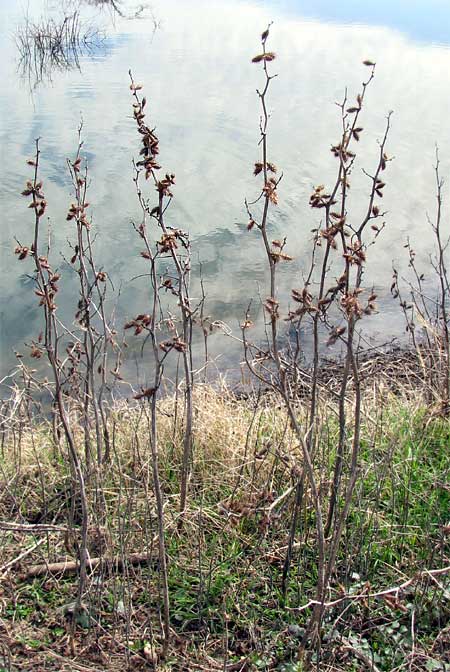
There were miles and miles of levees and miles and miles of cockleburs at the water's edge. Of course the plants in the picture are dead, for cockleburs are annual plants. However, dead cockleburs retain stiff stems that hold the spiny fruits up well into spring, the idea being that the fruits will latch onto a passing animal's fur and be carried to a new location. You can see how well equipped a bur is for that job below:
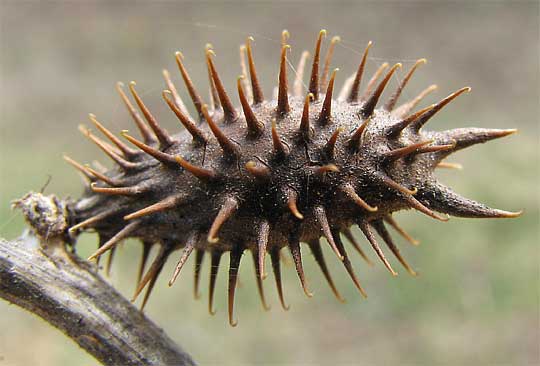
Cocklebur taxonomy is a matter of debate, some specialists recognizing only three species in the genus and others many more. The species pictured here is surely the Common Cocklebur, XANTHIUM STRUMARIUM, native to North America despite its aggressive weediness here.
from the March 10, 2013 Newsletter issued from the valley of the Dry Frio River in northern Uvalde County, southwestern Texas, on the southern border of the Edwards Plateau; elevation ~1750m (~5750 ft); N29.62°, W99.86°; USA
COCKLEBUR VARIATIONS
Along the banks of the little Dry Frio River behind the cabin Common Cockleburs with their leafless, dead stems still bearing burs produced last season can be seen, as shown below:
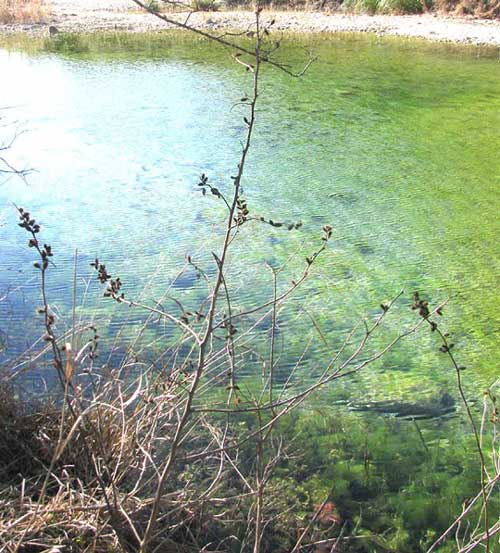
What draws my attention to these plants is that they are so tall -- about six feet (1.8m) and that their stems look and feel as woody as a small tree's. Cockleburs are annuals, though, and all the literature describes them as herbaceous.
The burs also are interesting because they're different from those I'm familiar with back in Kentucky and Mississippi. You can compare the bur illustrated in the above section with one from a plant along the Dry Frio shown below:
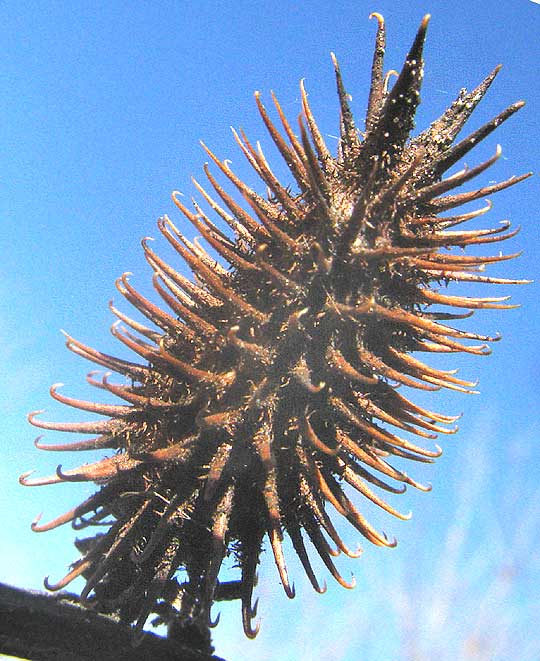
The main difference is that the Dry Frio burs' long, hooked spines themselves bear tiny, stiff spines at their bases -- spines on spines -- while the Mississippi burs' spines have smooth, spineless bases.
Back in the 60s when I was learning my plants in Kentucky I had a hard time identifying our local cockleburs to species level because our plants didn't match the descriptions in the technical keys I was using, and there were many species to choose from. Nowadays it's a lot simpler, since nearly all the "species" I wrestled with back in Kentucky now have been lumped into one very variable species, the Common Cocklebur, XANTHIUM STRUMARIUM. Now the entire genus Xanthium is thought to comprise only two or three species.
So, generations of botanists huffed and puffed and worked themselves into a sweat trying to figure out cocklebur taxonomy. There were great debates and mighty pronouncements but, in the end, now that we can look at the genes, we see that all those variations on the cocklebur theme never could have been properly assigned to any of the taxonomic pigeonholes thought up for the plant -- except for the one labeled "it's all the same."
Entry dated January 1, 2024, issued from near Tequisquiapan; elevation about 1,900m, (6200 ft), ~N20.57°, ~W99.89°; Querétaro state, MÉXICO
ANOTHER VARIATION
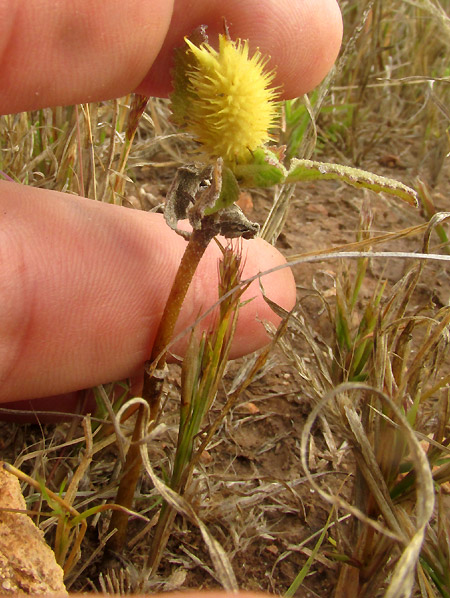
In the grips of a continuing two-year severe drought causing an abandoned field's grasses weedy grasses to appear as they do above, a stunted cocklebur plant bore a single bur, as shown above. Up close, the bur displayed spines on hooked spines as seen in a previous picture:

from the September 21, 2006 Newsletter issued from Polly's Bend, Garrard County, in Kentucky's Bluegrass Region, USA:
MEDICINAL COCKLEBUR
I read that young cocklebur plants in the two-leaf stage are poisonous enough to kill pigs and other animals. As often is the case, what's poisonous in one instance can be medicinal in another. Cockleburs are still used in traditional Chinese medicine.
At an AcupunctureToday.Com page where they call cocklebur by its genus name Xanthium I read:
"... xanthium is associated with the Lung meridian, and is considered to have sweet, bitter and warm properties. It is used to dispel wind and damp, and is one of the most important herbs used for sinus congestion, chronic nasal obstructions and discharges, and respiratory allergies."
The spiny fruit is what's used. The above site also informs us "some evidence suggests the toxicity can be removed by washing the fruit in water, subjecting it to high heat, or stir-frying it."
Stir-fried cockleburs...